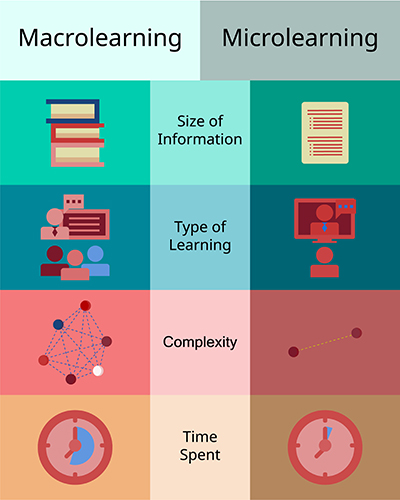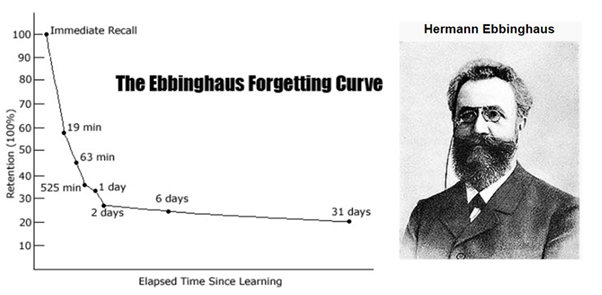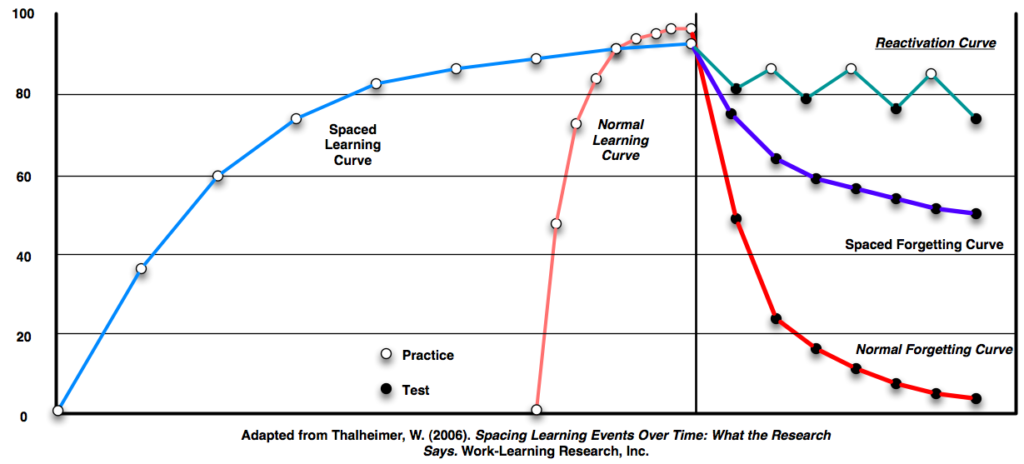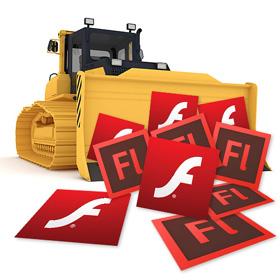Learning Snacks: Microlearning, Drip and Spaced Learning
One oft-quoted but mythical statistic floating around the internet says that goldfish have longer attention spans than people: goldfish with 8 seconds, and humans at 7 seconds. In our media saturated society, children and adults alike get bored easily. This might give credibility to this statistic, however, those same adults can watch a two hour movie or binge watch a television series for the evening and children absorbed in a video game must be torn away for meal and screen time breaks.  All are certainly longer than the 8 second timespan quoted in the 2015 Microsoft study cited in Time Magazine that planted the seeds of that myth. The mitigating factor here is what the attention is focused on. When people are engaged with something, their attention remains as long as there is interest. In eLearning, our mission is to design activities that capture and maintain that interest. Things are further compounded in the world of work where time is limited for learning activities, and they must be sandwiched between meetings and the tasks at hand.
All are certainly longer than the 8 second timespan quoted in the 2015 Microsoft study cited in Time Magazine that planted the seeds of that myth. The mitigating factor here is what the attention is focused on. When people are engaged with something, their attention remains as long as there is interest. In eLearning, our mission is to design activities that capture and maintain that interest. Things are further compounded in the world of work where time is limited for learning activities, and they must be sandwiched between meetings and the tasks at hand.
Enter the world of microlearning, drip, and spaced learning. Each has a distinct use case and provide short segments of learning that can readily be fit into the day.
Microlearning
Microlearning, as the name implies, consists of intentionally short bursts of learning. Some have called the lessons learning snacks. If you google for the best microlearning tools, a variety of review sites come up. They are often populated with marketing-speak promoting the virtues of the tool. To get past all that, let’s look at the big picture of what microlearning is, and what the tools to create it contain.
Microlearning can be text, images, short videos, audio, tests, quizzes or even interactive games. The key to microlearning is that each lesson contains a single topic and it is intentionally short. There is no official rule of thumb as to how long they should be, but most tend to be in the 5-10 minute range. It’s not about time though. It’s about the focus. There should be a single objective to be met as a result of the microlearning experience and it should be able to stand on its own.

Microlearning is not suitable for complex topics or in-depth training. It works well for things like onboarding where there are many little pieces to be assembled for the learner to be aware of, but the pieces are not contingent on one another. It’s great for reviewing content with questions about what they have learned elsewhere. It can work for new product training where there are only simple facts to remember about each item.
When you are determining if your content is suited for microlearning consider the size, type, complexity, and time available. You will not be able to teach an extended procedure through microlearning, but it works really well to introduce a new feature of software the users are familiar with.
Microlearning is quick to develop and deploy, and because it is housed in an independent platform, it’s easy to maintain. The key is having the right content for it. Splitting up a long course into small lessons is good practice for chunking, but it might not be a good fit for microlearning if there is a lot of sequencing and building required. Again, the key is that each microlearning unit covers a single objective and is self-contained, providing the content and practice to the learner in one sitting.
Most microlearning platforms are self-contained. They have an authoring feature that lets you build the content, a content management tool that lets you organize the microlearning that you have built, and a user management and reporting system that lets you add and group users and see how they are using your content. Most microlearning is intended to be deployed to the user’s smartphone for anytime, anywhere learning. TalentCards is a good example of this kind of platform. They have a free version you can experiment with to get a feel for it. (Tell them we sent you.)
Drip Learning
Remember when a television program had a cliff hanger and you had to wait a whole week or perhaps until next season to find out what happened? Serialized stories and tv shows are less popular in our world of on-demand access to things, but the serialized format has possibilities in the realms of microlearning. As I write this, we are two days beyond a snowstorm that dumped 14” of snow in the area, and as it is melting, I’m listening to the drip, drip, drip as it melts off of the rooftop. Drip learning is the difference between dumping 14 inches of snow vs. dribbling a bit of water a little at a time onto the lawn. Drip learning is a form of microlearning that is presented to the learner a little at a time over a series of time. It is often distributed over email, or a newsletter, but could be via text or even the LMS.

Drip learning is a scheduled delivery of chunked content. Beyond keeping the amount of learning manageable for the learners, it allows the learning team to review how the learners are accessing the content and promote more of the types of information they are liking. It also allows for the opportunity to answer questions between lessons. Drip learning leverages a spacing effect, so learners are able to process what has come within the week before stepping into the next piece. It’s learning a little at a time.
Drip learning can be pieces of content pushed out to learners a bit at a time on a schedule, or it might be content that is unlocked when a learner achieves a certain level. Keeping content size manageable and spaced out allows application between sessions and helps learners achieve their learning goals without overwhelming them. This is perfect for new hire training where there is so much to learn all at once.
Think about the last online compliance training you had to take. (Zzzzzzz, right?) Now imagine that as drip learning, spaced out over a few weeks, a little at time over email, with a serialized, cliff-hanger story. What would the possibilities be if the learner had to complete some task in order to unlock the next episode? This is the power of drip learning with gamified motivators.
Spaced Learning
Spaced learning is similar to drip learning, but with spaced learning, we repeat the same information multiple times in varying ways over time. This helps to overcome the impacts of the “Forgetting Curve”. Recall what you learned in your last class or eLearning course. Unless you completed it a few moments ago, it’s likely that you only remember a small fraction of it. That’s the forgetting curve in action.

The concept of the Forgetting Curve was developed in the late 1800s by a German psychologist named Hermann Ebbinghaus, so it’s often referred to as the Ebbinghaus Effect or the Ebbinghaus Forgetting Curve. He studied and charted recall in people who were given a list of words to remember, measuring the number of words they could retrieve over time. He recognized that the more time elapsed, the less people remembered. When people finished memorizing the list, within 20 minutes, they could only recall 58% of the words, within an hour, 44%, at the end of a day 33%, and after a month, only 21%.
While we cannot generalize this to all learning, since variables like context, scaffolding, using the information right away, emotional connections, relationships between the words, mnemonics and a variety of other memory strategies influence what is recalled, an important principle comes into play for those of us in the learning industry: Just because you taught it, doesn’t mean they caught it. When our learners need to remember facts, spaced learning can overcome the forgetting curve. Think about how you learned your multiplication tables. I’ll bet you used flashcards, which is a form of spaced learning.
According to the work by Will Thalheimer and Clark Quinn of Qunninovations, spaced learning has multiple applications. If you look at the red line, which represents our normal learning patterns, we learn something in a class or through eLearning, and then retention falls off rapidly, as identified by Ebbinghaus.
 The blue line shows how learning can be built over time, leveraging the spacing effect and lessening the forgetting curve. Recall is improved by reactivating the learning at intervals afterward. One way of reactivating the learning is with a quiz question. Mindmarker has done an excellent job creating a tool that leverages this type of reinforcement in a gamified format. They not only ask the question, but ask the learner to rate their confidence level on their answer. As the information is reinforced, learner confidence is strengthened. We don’t want to have learners guessing that their answer is correct. We want them to know that they know. Mindmarker incorporates team competition, increasing the motivation for the review questions, and ultimately building stronger learning.
The blue line shows how learning can be built over time, leveraging the spacing effect and lessening the forgetting curve. Recall is improved by reactivating the learning at intervals afterward. One way of reactivating the learning is with a quiz question. Mindmarker has done an excellent job creating a tool that leverages this type of reinforcement in a gamified format. They not only ask the question, but ask the learner to rate their confidence level on their answer. As the information is reinforced, learner confidence is strengthened. We don’t want to have learners guessing that their answer is correct. We want them to know that they know. Mindmarker incorporates team competition, increasing the motivation for the review questions, and ultimately building stronger learning.
Summary
Microlearning, drip learning, and spaced learning are three more tools you can leverage to bring content to your users. At Illumina, we can help you with all three. During these pandemic times, these small chunks are especially useful when your learners must fit things in between Zoom meetings, Zoom school with the kids, and the pressure cooker of being quarantined at home. Let our consistent award-winning eLearning development team help you make your learning something people want to snack on. We’ve been creating custom eLearning for almost 25 years – courses that compel learner engagement and retention while significantly lessening the impact of the Forgetting Curve.
We’re happy to jump on a complimentary strategy call or schedule a deep-dive demo and explore coming alongside of you on your next eLearning initiative.
Jean Marrapodi is a thought leader in the online learning industry and consultant to Illumina Interactive. In March of 2016, Jean was honored by the eLearning Guild as the recipient of the Guild Master Award in recognition of her outstanding contributions to the eLearning Guild and the Learning Technologies industry.




